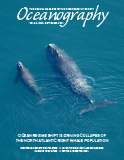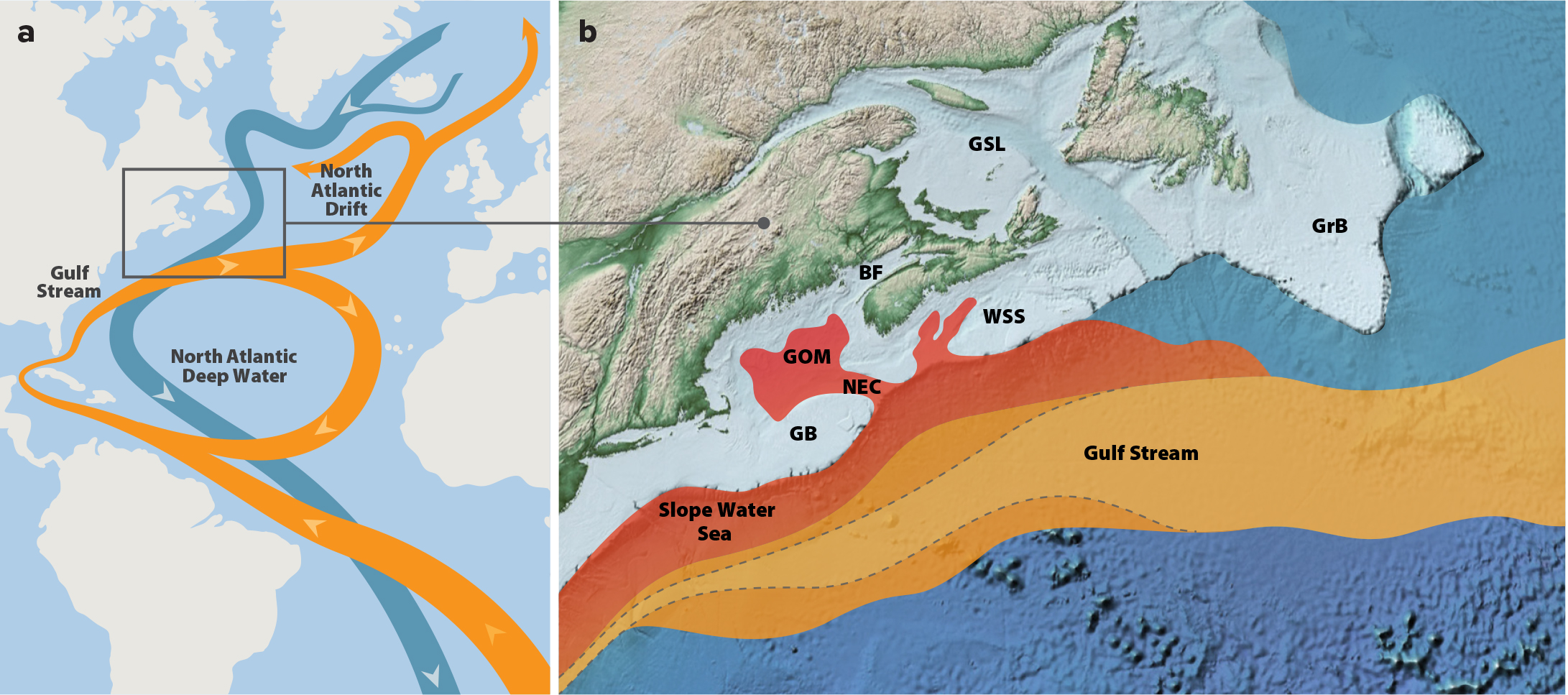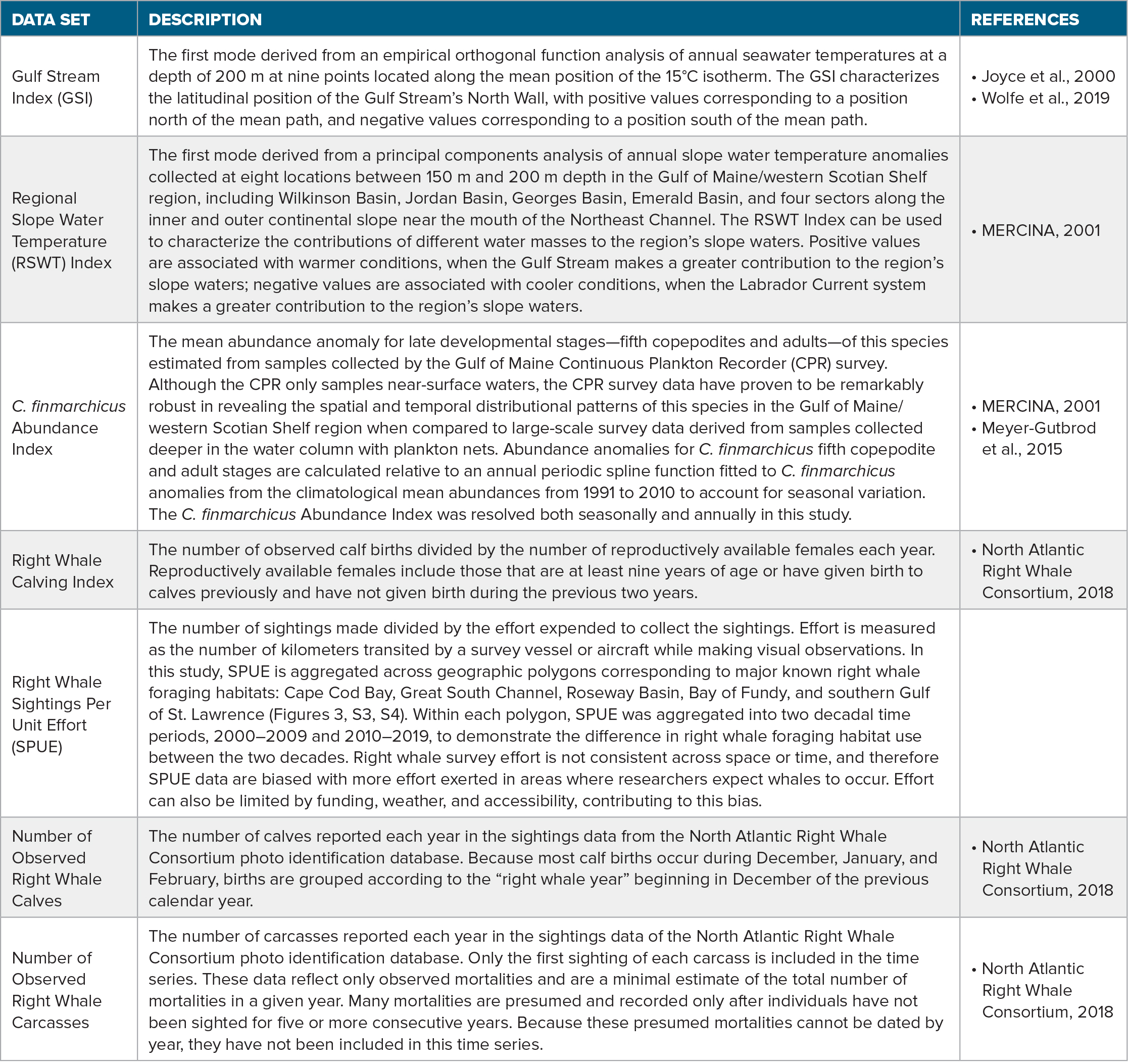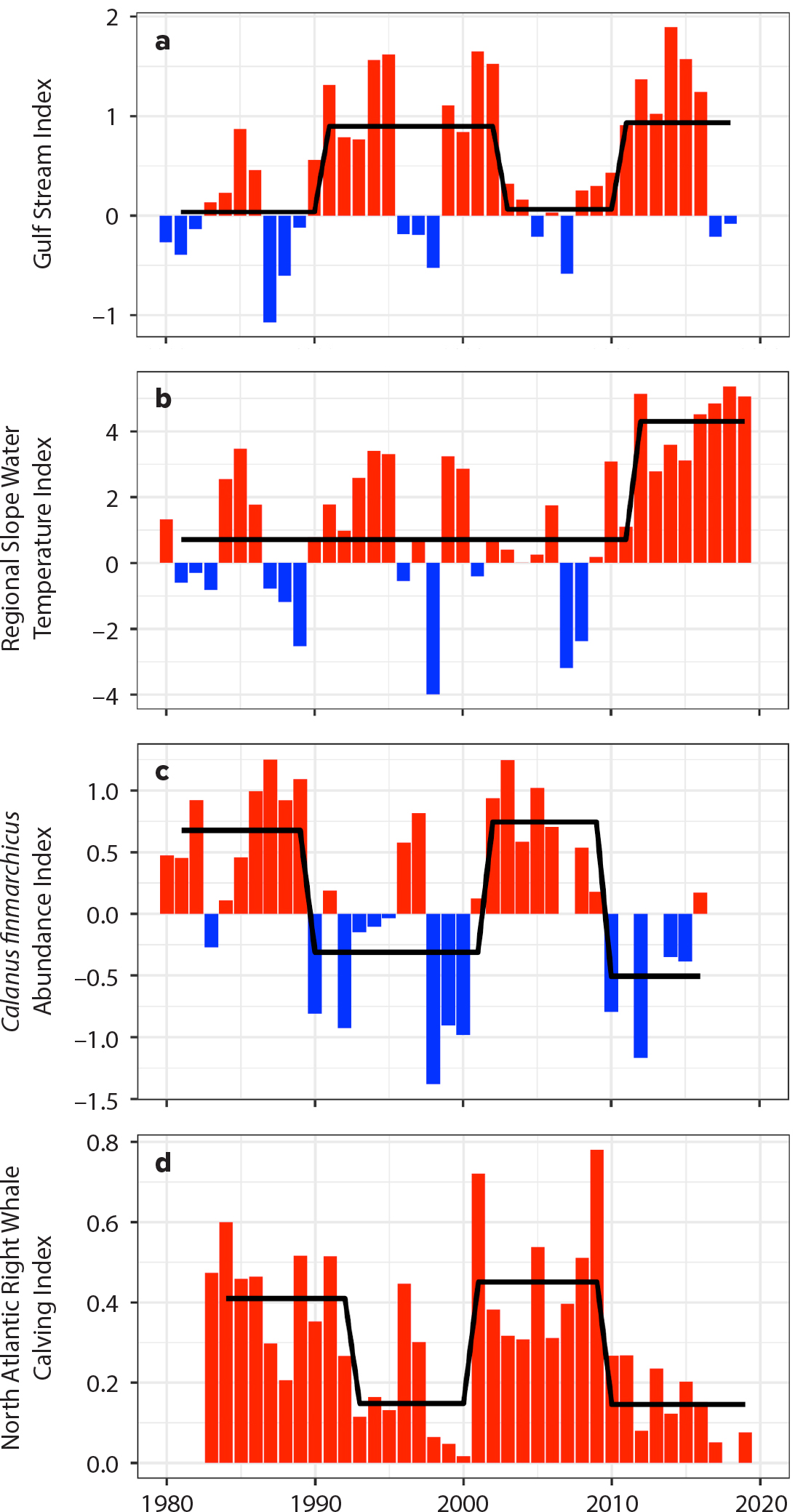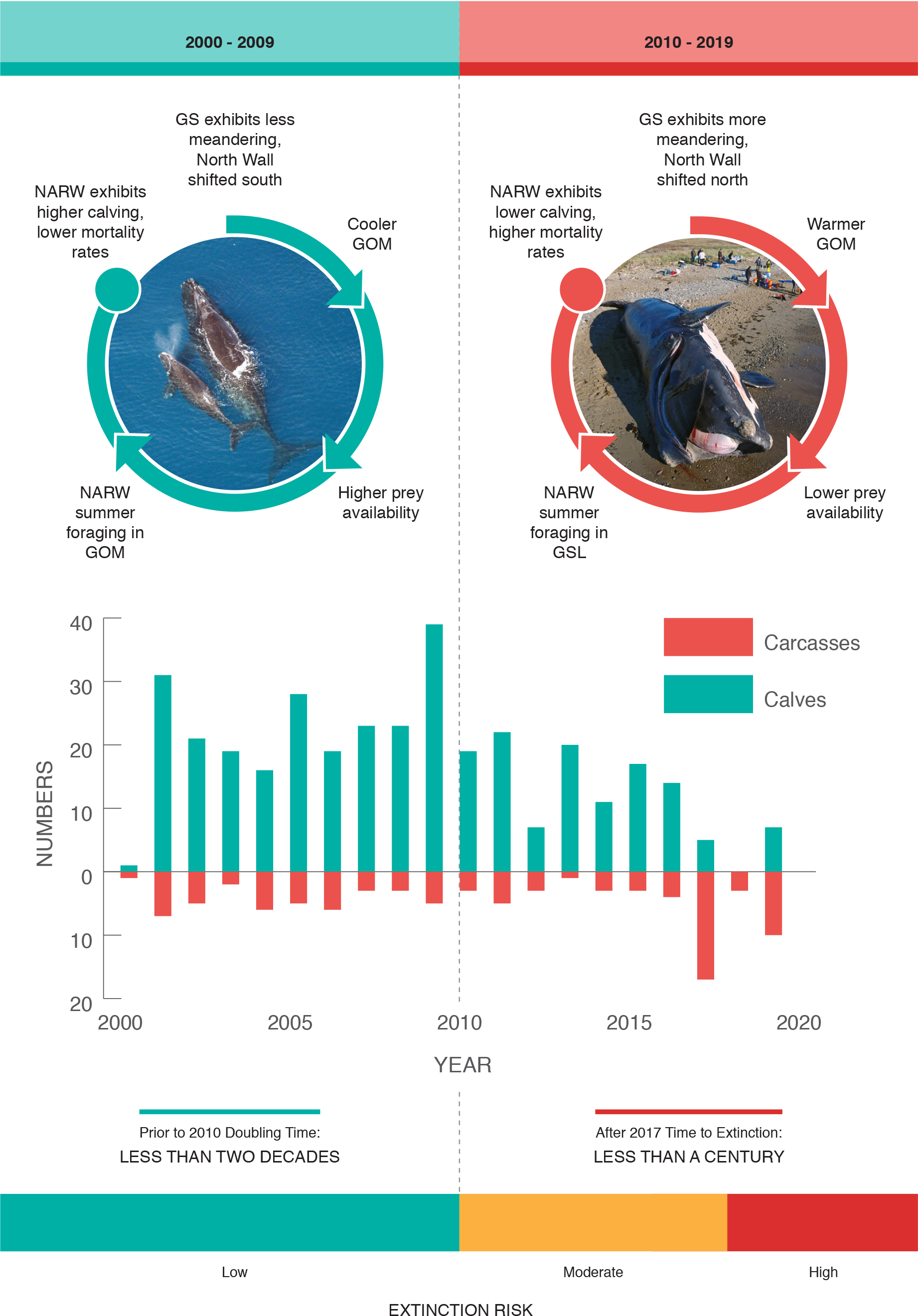Andres, M. 2016. On the recent destabilization of the Gulf Stream path downstream of Cape Hatteras. Geophysical Research Letters 43:9,836–9,842, https://doi.org/10.1002/2016GL069966.
Caesar, L., S. Rahmstorf, A. Robinson, G. Feulner, and V. Saba. 2018. Observed fingerprint of a weakening Atlantic Ocean overturning circulation. Nature 556(7700):191–196, https://doi.org/10.1038/s41586-018-0006-5.
Chen, K., G. Gawarkiewicz, Y.O. Kwon, and W.G. Zhang. 2015. The role of atmospheric forcing versus ocean advection during the extreme warming of the Northeast US continental shelf in 2012. Journal of Geophysical Research: Oceans 120(6):4,324–4,339, https://doi.org/10.1002/2014JC010547.
Davies, K.T., and S.W. Brillant. 2019. Mass human-caused mortality spurs federal action to protect endangered North Atlantic right whales in Canada. Marine Policy 104:157–162, https://doi.org/10.1016/j.marpol.2019.02.019.
Davies, K.T., M.W. Brown, P.K. Hamilton, A.R. Knowlton, C.T. Taggart, and A.S. Vanderlaan. 2019. Variation in North Atlantic right whale Eubalaena glacialis occurrence in the Bay of Fundy, Canada, over three decades. Endangered Species Research 39:159–171, https://doi.org/10.3354/esr00951.
Frölicher, T.L., E.M. Fischer, and N. Gruber. 2018. Marine heatwaves under global warming. Nature 560:360–364, https://doi.org/10.1038/s41586-018-0383-9.
Ganley, L.C., S. Brault, and C.A. Mayo. 2019. What we see is not what there is: Estimating North Atlantic right whale Eubalaena glacialis local abundance. Endangered Species Research 38:101–113, https://doi.org/10.3354/esr00938.
Gavrilchuk, K., V. Lesage, S.M. Fortune, A.W. Trites, and S. Plourde. 2021. Foraging habitat of North Atlantic right whales has declined in the Gulf of St. Lawrence, Canada, and may be insufficient for successful reproduction. Endangered Species Research 44:113–136, https://doi.org/10.3354/esr01097.
Gawarkiewicz, G., R.E. Todd, W. Zhang, J. Partida, A. Gangopadhyay, M.-U.-H. Monim, P. Fratantoni, A. Malek Mercer, and M. Dent. 2018. The changing nature of shelf-break exchange revealed by the OOI Pioneer Array. Oceanography 31(1):60–70, https://doi.org/10.5670/oceanog.2018.110.
Goodyear, J.D. 1996. Significance of Feeding Habitats of North Atlantic Right Whales Based on Studies of Diel Behaviour, Diving, Food Ingestion Rates, and Prey. PhD Dissertation, Guelph University.
Greene, C.H., A.J. Pershing, R.D. Kenney, and J.W. Jossi. 2003. Impact of climate variability on the recovery of endangered North Atlantic right whales. Oceanography 16(4):98–103, https://doi.org/10.5670/oceanog.2003.16.
Greene, C.H., and A.J. Pershing. 2004. Climate and the conservation biology of North Atlantic right whales: The right whale at the wrong time? Frontiers in Ecology and the Environment 2(1):29–34, https://doi.org/10.1890/1540-9295(2004)002[0029:CATCBO]2.0.CO;2.
Greene, C.H., E. Meyer-Gutbrod, B.C. Monger, L.P. McGarry, A.J. Pershing, I.M. Belkin, P.S. Fratantoni, D.G. Mountain, R.S. Pickart, A. Proshutinsky, and others. 2013. Remote climate forcing of decadal-scale regime shifts in Northwest Atlantic shelf ecosystems. Limnology and Oceanography 58(3):803–816, https://doi.org/10.4319/lo.2013.58.3.0803.
Greene, C.H. 2016. North America’s iconic marine species at risk due to unprecedented ocean warming. Oceanography 29(3):14–17, https://doi.org/10.5670/oceanog.2016.67.
Henry, A.G., M. Garron, D. Morin, A. Reid, W. Ledwell, and T.V.N. Cole. 2020. Serious Injury and Mortality Determinations for Baleen Whale Stocks along the Gulf of Mexico, United States East Coast, and Atlantic Canadian Provinces, 2013–2017. US Department of Commerce, Northeast Fisheries Science Center Reference Document 20-06, 53 pp., https://repository.library.noaa.gov/view/noaa/25359.
Ji, R., Z. Feng, B.T. Jones, C. Thompson, C. Chen, N.R. Record, and J.A. Runge. 2017. Coastal amplification of supply and transport (CAST): A new hypothesis about the persistence of Calanus finmarchicus in the Gulf of Maine. ICES Journal of Marine Science 74(7):1,865–1,874, https://doi.org/10.1093/icesjms/fsw253.
Joyce, T.M., C. Deser, and M.A. Spall. 2000. The relation between decadal variability of subtropical mode water and the North Atlantic Oscillation. Journal of Climate 13:2,550–2,569, https://doi.org/10.1175/1520-0442(2000)013<2550:TRBDVO>2.0.CO;2.
Jutras, M., C.O. Dufour, A. Mucci, F. Cyr, and D. Gilbert. 2020. Temporal changes in the causes of the observed oxygen decline in the St. Lawrence Estuary. Journal of Geophysical Research: Oceans 125(12):e2020JC016577, https://doi.org/10.1029/2020JC016577.
Knowlton, A.R., P.K. Hamilton, M.K. Marx, H.M. Pettis, and S.D. Kraus. 2012. Monitoring North Atlantic right whale Eubalaena glacialis entanglement rates: A 30 yr retrospective. Marine Ecology Progress Series 466:293–302, https://doi.org/10.3354/meps09923.
Kraus, S.D., and R. Rolland, eds. 2007. The Urban Whale: North Atlantic Right Whales at the Crossroads. Harvard University Press, Cambridge, MA, 576 pp.
MERCINA (Marine Ecosystem Responses to Climate in the North Atlantic). 2001. Oceanographic responses to climate in the Northwest Atlantic. Oceanography 14(3):76–82, https://doi.org/10.5670/oceanog.2001.25.
MERCINA. 2004. Supply-side ecology and the response of zooplankton to climate-driven changes in the North Atlantic Ocean. Oceanography 17(3):60–71, https://doi.org/10.5670/oceanog.2004.31.
MERCINA. 2012. Recent Arctic climate change and its remote forcing of Northwest Atlantic shelf ecosystems. Oceanography 25(3):208–213, https://doi.org/10.5670/oceanog.2012.64.
Meyer-Gutbrod, E.L., and C.H. Greene. 2014. Climate-associated regime shifts drive decadal-scale variability in recovery of North Atlantic right whale population. Oceanography 27(3):148–153, http://doi.org/10.5670/oceanog.2014.64.
Meyer-Gutbrod, E.L., C.H. Greene, P.J. Sullivan, and A.J. Pershing. 2015. Climate-associated changes in prey availability drive reproductive dynamics of the North Atlantic right whale population. Marine Ecology Progress Series 535:243–258, https://doi.org/10.3354/meps11372.
Meyer-Gutbrod, E.L., and C.H. Greene. 2018. Uncertain recovery of the North Atlantic right whale in a changing ocean. Global Change Biology 24:455–464, https://doi.org/10.1111/gcb.13929.
Meyer-Gutbrod, E.L., C.H. Greene, and K.T.A. Davies. 2018. Marine species range shifts necessitate advanced policy planning: The case of the North Atlantic right whale. Oceanography 31(2):19–23, https://doi.org/10.5670/oceanog.2018.209.
Neto, A.G., J.A. Langan, and J.B. Palter. 2021. Changes in the Gulf Stream preceded rapid warming of the Northwest Atlantic Shelf. Communications Earth & Environment 2(1):74, https://doi.org/10.1038/s43247-021-00143-5.
North Atlantic Right Whale Consortium. 2018. North Atlantic Right Whale Consortium Sightings and Identification Databases. New England Aquarium, Boston, MA, https://www.narwc.org/narwc-databases.html.
Pace, R.M. III, P.J. Corkeron, and S.D. Kraus. 2017. State-space mark-recapture estimates reveal a recent decline in abundance of North Atlantic right whales. Ecology and Evolution 7(21):8,730–8,741, https://doi.org/10.1002/ece3.3406.
Pace, R.M. III, R. Williams, S.D. Kraus, A.R. Knowlton, and H.M. Pettis. 2021. Cryptic mortality of North Atlantic right whales. Conservation Science and Practice 3(2):e346, https://doi.org/10.1111/csp2.346.
Parks, S.E., A. Searby, A. Célérier, M.P. Johnson, D.P. Nowacek, and P.L. Tyack. 2011. Sound production behavior of individual North Atlantic right whales: Implications for passive acoustic monitoring. Endangered Species Research 15(1):63–76, https://doi.org/10.3354/esr00368.
Pershing, A.J., M.A. Alexander, C.M. Hernandez, L.A. Kerr, A. Le Bris, K.E. Mills, J.A. Nye, N.R. Record, H.A. Scannell, J.D. Scott, and G.D. Sherwood. 2015. Slow adaptation in the face of rapid warming leads to collapse of the Gulf of Maine cod fishery. Science 350(6262):809–812, https://doi.org/10.1126/science.aac9819.
Pettis, H.M., R.M. Pace III, and P.K. Hamilton. 2020. North Atlantic Right Whale Consortium 2019 annual report card. North Atlantic Right Whale Consortium, Boston, MA, https://www.narwc.org/report-cards.html.
Pettis, H.M., R.M. Pace III, and P.K. Hamilton. 2021. North Atlantic Right Whale Consortium 2020 annual report card. North Atlantic Right Whale Consortium, Boston, MA, https://www.narwc.org/report-cards.html.
Pinsky, M.L., B. Worm, M.J. Fogarty, J.L. Sarmiento, and S.A. Levin. 2013. Marine taxa track local climate velocities. Science 341(6151):1,239–1,242, https://doi.org/10.1126/science.1239352.
Pinsky, M.L., and N.J. Mantua. 2014. Emerging adaptation approaches for climate-ready fisheries management. Oceanography 27(4):146–159, https://doi.org/10.5670/oceanog.2014.93.
Pinsky, M.L., G. Reygondeau, R. Caddell, J. Palacios-Abrantes, J. Spijkers, and W.W. Cheung. 2018. Preparing ocean governance for species on the move. Science 360:1,189–1,191, https://doi.org/10.1126/science.aat2360.
Rahmstorf, S. 1997. Risk of sea-change in the Atlantic. Nature 388:825–826, https://doi.org/10.1038/42127.
Rahmstorf, S., J.E. Box, G. Feulner, M.E. Mann, A. Robinson, S. Rutherford, and E.J. Schaffernicht. 2015. Exceptional twentieth-century slowdown in Atlantic Ocean overturning circulation. Nature Climate Change 5(5):475–480, https://doi.org/10.1038/nclimate2554.
Record, N.R., J.A. Runge, D.E. Pendleton, W.M. Balch, K.T.A. Davies, A.J. Pershing, C.L. Johnson, K. Stamieszkin, R. Ji, Z. Feng, and others. 2019. Rapid climate-driven circulation changes threaten conservation of endangered North Atlantic right whales. Oceanography 32(2):162–169, https://doi.org/10.5670/oceanog.2019.201.
Reygondeau, G., and G. Beaugrand. 2011. Future climate-driven shifts in distribution of Calanus finmarchicus. Global Change Biology 17(2):756–766, https://doi.org/10.1111/j.1365-2486.2010.02310.x.
Rodionov, S.N. 2004. A sequential algorithm for testing climate regime shifts. Geophysical Research Letters 31(9), https://doi.org/10.1029/2004GL019448.
Rodionov, S.N. 2006. Use of pre-whitening in climate regime shift detection. Geophysical Research Letters 33(12), https://doi.org/10.1029/2006GL025904.
Saba, V.S., S.M. Griffies, W.G. Anderson, M. Winton, M.A. Alexander, T.L. Delworth, J.A. Hare, M.J. Harrison, A. Rosati, G.A. Vecchi, and R. Zhang. 2016. Enhanced warming of the Northwest Atlantic Ocean under climate change. Journal of Geophysical Research 121(1):118–132, https://doi.org/10.1002/2015JC011346.
Scannell, H.A., A.J. Pershing, M.A. Alexander, A.C. Thomas, and K.E. Mills. 2016. Frequency of marine heatwaves in the North Atlantic and North Pacific since 1950. Geophysical Research Letters 43:2,069–2,076, https://doi.org/10.1002/2015GL067308.
Schlegel, R.W., E.C. Oliver, and K. Chen. 2021. Drivers of marine heatwaves in the Northwest Atlantic: The role of air–sea interaction during onset and decline. Frontiers in Marine Science 8:627970, https://doi.org/10.3389/fmars.2021.627970.
Seidov, D., A. Mishonov, and R. Parsons. 2021. Recent warming and decadal variability of Gulf of Maine and slope water. Limnnology and Oceanography, https://doi.org/10.1002/lno.11892.
Simard, Y., N. Roy, S. Giard, and F. Aulanier. 2019. North Atlantic right whale shift to the Gulf of St. Lawrence in 2015, revealed by long-term passive acoustics. Endangered Species Research 40:271–284, https://doi.org/10.3354/esr01005.
Sorochan, K.A., S. Plourde, R. Morse, P. Pepin, J. Runge, C. Thompson, and C.L. Johnson. 2019. North Atlantic right whale (Eubalaena glacialis) and its food: Part II. Interannual variations in biomass of Calanus spp. on western North Atlantic shelves. Journal of Plankton Research 41:687–708, https://doi.org/10.1093/plankt/fbz044.
Smale, D.A., T. Wernberg, E.C.J. Oliver, M. Thomsen, B.P. Harvey, S.C. Straub, M.T. Burrows, L.V. Alexander, J.A. Benthuysen, M.G. Donat, and others. 2019. Marine heatwaves threaten global biodiversity and the provision of ecosystem services. Nature Climate Change 9:306–312, https://doi.org/10.1038/s41558-019-0412-1.
Sunday, J.M., A.E. Bates, and N.K. Dulvy. 2012. Thermal tolerance and the global redistribution of animals. Nature Climate Change 2:686–690, https://doi.org/10.1038/nclimate1539.
Sydeman, W.J., E. Poloczanska, T.E. Reed, and S.A. Thompson. 2015. Climate change and marine vertebrates. Science 350:772–777, https://doi.org/10.1126/science.aac9874.
Wolfe, C.L., S. Hameed, and L. Chi. 2019. On the drivers of decadal variability of the Gulf Stream north wall. Journal of Climate 32(4):1,235–1,249, https://doi.org/10.1175/JCLI-D-18-0212.1.

